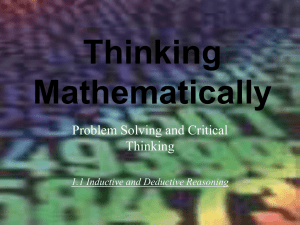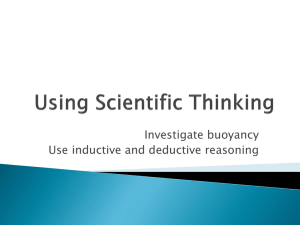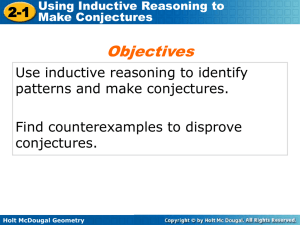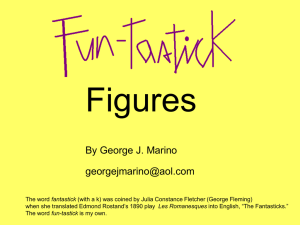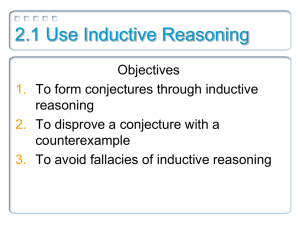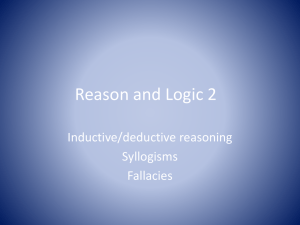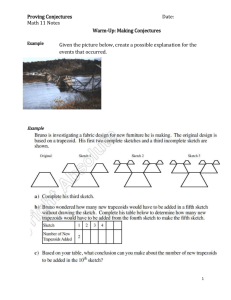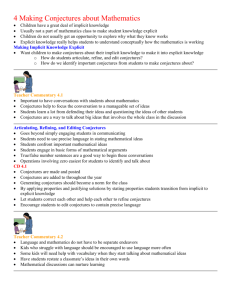Unit A - What is Proof?
advertisement
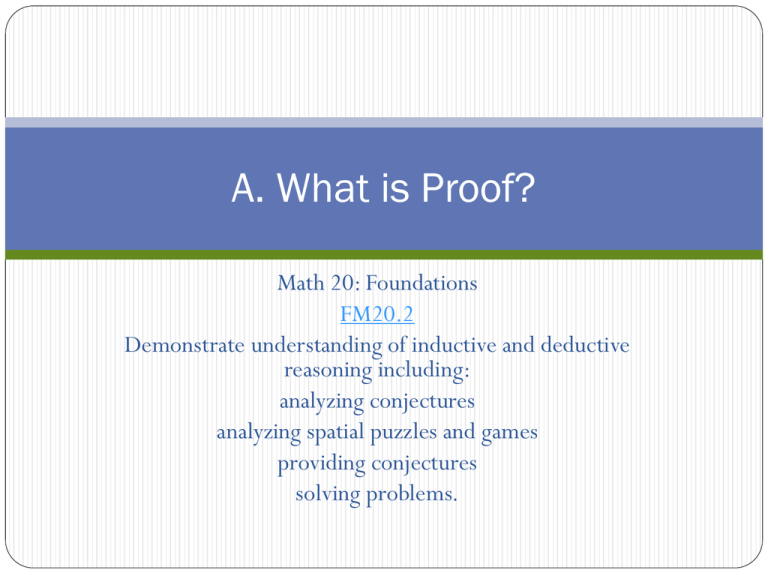
A. What is Proof? Math 20: Foundations FM20.2 Demonstrate understanding of inductive and deductive reasoning including: analyzing conjectures analyzing spatial puzzles and games providing conjectures solving problems. Time to Get Started! The Mystery of the Mary Celeste p.4 Work through with a partner. You have 15 minutes. What DO YOU Think? p.5 1. What is Enough Proof? FM20.2 Demonstrate understanding of inductive and deductive reasoning including: analyzing conjectures analyzing spatial puzzles and games providing conjectures solving problems. 1. What is Enough Proof? Conjecture – A testable expression that is based on available evidence but is not yet proved. Inductive Reasoning - Drawing a general conclusion by observing patterns and identifying properties in specific examples. Investigate the Math p.6 Example 1 Example 2 Is this conjecture convincing? Why or why not? Example 3 Example 4 Summary p. 12 Practice Ex. 1.1 (p.12) #1-14 #3-19 2. How to Prove Conjectures FM20.2 Demonstrate understanding of inductive and deductive reasoning including: analyzing conjectures analyzing spatial puzzles and games providing conjectures solving problems. 2. How to Prove Conjectures Turn to page 16. Choose 2 illusions and develop a conjecture by looking at the illusions Next prove the conjecture. Your brain can be deceived that is why Inductive Reasoning can lead you to a conjecture but can not prove it for all cases. Practice Ex. 1.2 (p.17) #1-3 3. What is a Counterexample? FM20.2 Demonstrate understanding of inductive and deductive reasoning including: analyzing conjectures analyzing spatial puzzles and games providing conjectures solving problems. 3. What is a Counterexample? When points on the circumference of circle are joined by chords the circle is divided into sections Conjecture: As the number of connected points on the circumference of a circle increases by 1, the number of regions created within the circle increases by a factor of 2. How can we prove this? When we try 6 points on the circumference of a circle it does not increase by a factor of 2 This is called a counterexample because it disproves our conjecture. Why is only one counterexample enough to disprove a conjecture? Example 1 Previously we made 2 conjectures about the difference between consecutive perfect squares. The difference between two consecutive perfect squares is a prime number. The difference between two consecutive perfect squares is an odd number. Find a counterexample for each conjecture. Find another counterexample for the first conjecture. Can you find a counterexample for the second conjecture? Example 2 Summary p.22 Practice Ex. 1.3 (p.22) #1-16 #3-19 4. Proving for All Cases FM20.2 Demonstrate understanding of inductive and deductive reasoning including: analyzing conjectures analyzing spatial puzzles and games providing conjectures solving problems. 4. Proving for All Cases Proving something to be true for all cases by drawing a specific conclusions through logical reasoning by starting with general assumptions that are known to be valid is called Deductive Reasoning So what does this mean? Lets look at the following conjecture. 𝑆 = 𝑥 − 2 + 𝑥 − 1 + 𝑥 + 𝑥 + 1 + (𝑥 + 2) This is referred to as a generalization because it is something we know to be true, in general. What type of reasoning did Jon use? What type of reasoning did we use? How does this differ from what Jon used? Example 1 We have been looking at the difference between 2 consecutive perfect squares. We last time came up with the conjecture that the difference between 2 consecutive perfect squares is an odd number. Let’s prove this for all cases. Example 2 a) b) Transitive Property: If two quantities are equal to the same quantity, then they are equal to each other. If a = b and b = c, then a = c. Example 3 The process we just used to complete the previous example is referred to as a Two Column Proof Example 4 Summary p. 31 Practice Ex. 1.4 (p.31) #1-14 #4-18 5. Finding Holes in you Proofs! FM20.2 Demonstrate understanding of inductive and deductive reasoning including: analyzing conjectures analyzing spatial puzzles and games providing conjectures solving problems. 5. Finding Holes in you Proofs! Invalid Proof – A proof that contains an error in reasoning or that contains invalid assumptions. Premise – A statement assumed to be true. Circular Reasoning – An argument that is incorrect because it makes use of the conclusion to be proved. Investigate the Math p.36 Example 1 Example 2 Example 3 Example 4 Is there a number that will not work in Hossai’s number trick? Explain. Example 5 Summary p.41 Practice Ex. 1.5 (p.42) #1-7 #3-10 6. Solving Problems with Reasoning FM20.2 Demonstrate understanding of inductive and deductive reasoning including: analyzing conjectures analyzing spatial puzzles and games providing conjectures solving problems. 6. Solving Problems with Reasoning Try the Trick for some different numbers and see if it is true. Use deductive reasoning to try and prove the number trick. Investigate the Math p.45 Investigate the Math p.45 Example 1 Did we use inductive reasoning or deductive reasoning? Example 2 Did we use inductive reasoning or deductive reasoning? Summary p.48 Practice Ex. 1.6 (p.48) #1-14 #3-16 7. Some Puzzles and Games FM20.2 Demonstrate understanding of inductive and deductive reasoning including: analyzing conjectures analyzing spatial puzzles and games providing conjectures solving problems. 7. Some Puzzles and Games Start with one marker each, then 2, then 3 and continue until 5 markers. Find the minimum number of moves for each situation and record the results in a table Investigate the Math p. 52 Example 1 Summary p. 55 Practice Ex. 1.7 (p. 55) #1-13 #4-15
